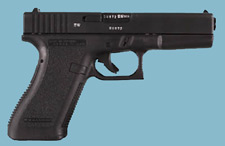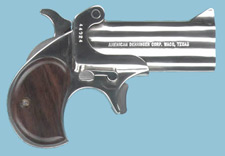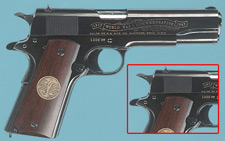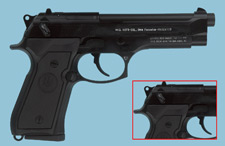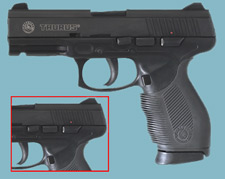Home | Glossary | Resources | Help | Contact Us | Course Map
Archival Notice
This is an archive page that is no longer being updated. It may contain outdated information and links may no longer function as originally intended.
Autoloading - Full Automatic Pistols
With a single trigger pull, pistols in full automatic mode (with trigger fully depressed and cartridges in the feed system) do the following:
- Feed cartridges
- Fire the shot
- Extract and eject cartridge cases
- Continue the cycle (until ammunition is depleted or trigger is released)
Full automatic pistols fall into two categories:
- Full automatic by design, with a selector switch that allows the shooter to fire in the full or semiautomatic mode
- Semiautomatic pistol modified to fire full automatic
Single- and Multibarreled Pistols
Pistols may be designed to fire only one shot at a time. These types of pistols may have one or more barrels. With each pull of the trigger, a single shot is fired. When a barrel is emptied after firing, the shooter must manually unload and reload.
The most common design is the break open pistol, which has a locking device that must be released to allow the chamber area of the barrel(s) to tip up and away from the breech for loading and unloading.
Trigger Systems
Single- or multibarrel pistols have trigger systems similar to revolvers.
Semiautomatic and full automatic pistols can have
- single-action trigger system,
- double-action trigger system,
- double-action-only trigger system.
The single-action trigger is the most common system. The only function of the trigger is to discharge the firearm. The firearm cannot be cocked by use of the trigger. In firearms with an external hammer, the hammer may be manually cocked; in striker-fired weapons,the slide must be pulled to the rear and released to cock the firearm.
In the double-action system, the hammer can be at rest. Pulling the trigger cocks the hammer and fires the weapon. After the first shot is fired in double-action mode the remaining shots are fired in the single-action mode. This occurs because the firing cycle cocks the firearm after each shot until the hammer is manually placed at rest.
The double-action-only (DAO) trigger system cocks and fires the firearm after each shot. The hammer returns to the rest position after each shot.
Additional Online Courses
- What Every First Responding Officer Should Know About DNA Evidence
- Collecting DNA Evidence at Property Crime Scenes
- DNA – A Prosecutor’s Practice Notebook
- Crime Scene and DNA Basics
- Laboratory Safety Programs
- DNA Amplification
- Population Genetics and Statistics
- Non-STR DNA Markers: SNPs, Y-STRs, LCN and mtDNA
- Firearms Examiner Training
- Forensic DNA Education for Law Enforcement Decisionmakers
- What Every Investigator and Evidence Technician Should Know About DNA Evidence
- Principles of Forensic DNA for Officers of the Court
- Law 101: Legal Guide for the Forensic Expert
- Laboratory Orientation and Testing of Body Fluids and Tissues
- DNA Extraction and Quantitation
- STR Data Analysis and Interpretation
- Communication Skills, Report Writing, and Courtroom Testimony
- Español for Law Enforcement
- Amplified DNA Product Separation for Forensic Analysts


